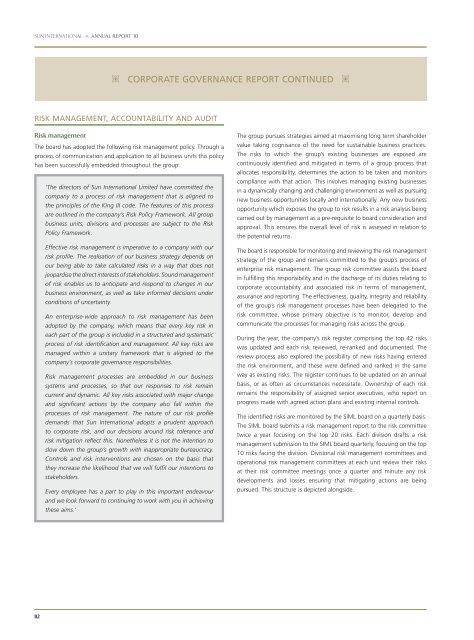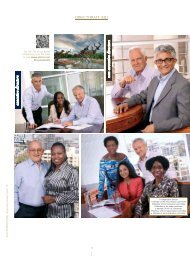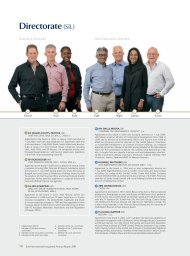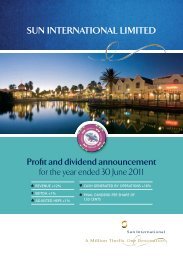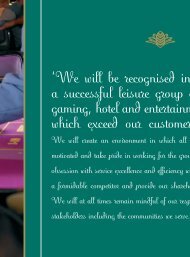PDF 25 MB - Sun International | Investor Centre
PDF 25 MB - Sun International | Investor Centre
PDF 25 MB - Sun International | Investor Centre
Create successful ePaper yourself
Turn your PDF publications into a flip-book with our unique Google optimized e-Paper software.
SUN INTERNATIONAL ANNUAL REPORT ’10<br />
RISK MANAGEMENT, ACCOUNTABILITY AND AUDIT<br />
Risk management<br />
112<br />
CORPORATE GOVERNANCE REPORT CONTINUED<br />
The board has adopted the following risk management policy. Through a<br />
process of communication and application to all business units this policy<br />
has been successfully embedded throughout the group:<br />
‘The directors of <strong>Sun</strong> <strong>International</strong> Limited have committed the<br />
company to a process of risk management that is aligned to<br />
the principles of the King III code. The features of this process<br />
are outlined in the company’s Risk Policy Framework. All group<br />
business units, divisions and processes are subject to the Risk<br />
Policy Framework.<br />
Effective risk management is imperative to a company with our<br />
risk profile. The realisation of our business strategy depends on<br />
our being able to take calculated risks in a way that does not<br />
jeopardise the direct interests of stakeholders. Sound management<br />
of risk enables us to anticipate and respond to changes in our<br />
business environment, as well as take informed decisions under<br />
conditions of uncertainty.<br />
An enterprise-wide approach to risk management has been<br />
adopted by the company, which means that every key risk in<br />
each part of the group is included in a structured and systematic<br />
process of risk identification and management. All key risks are<br />
managed within a unitary framework that is aligned to the<br />
company’s corporate governance responsibilities.<br />
Risk management processes are embedded in our business<br />
systems and processes, so that our responses to risk remain<br />
current and dynamic. All key risks associated with major change<br />
and significant actions by the company also fall within the<br />
processes of risk management. The nature of our risk profile<br />
demands that <strong>Sun</strong> <strong>International</strong> adopts a prudent approach<br />
to corporate risk, and our decisions around risk tolerance and<br />
risk mitigation reflect this. Nonetheless it is not the intention to<br />
slow down the group’s growth with inappropriate bureaucracy.<br />
Controls and risk interventions are chosen on the basis that<br />
they increase the likelihood that we will fulfil our intentions to<br />
stakeholders.<br />
Every employee has a part to play in this important endeavour<br />
and we look forward to continuing to work with you in achieving<br />
these aims.’<br />
The group pursues strategies aimed at maximising long term shareholder<br />
value taking cognisance of the need for sustainable business practices.<br />
The risks to which the group’s existing businesses are exposed are<br />
continuously identified and mitigated in terms of a group process that<br />
allocates responsibility, determines the action to be taken and monitors<br />
compliance with that action. This involves managing existing businesses<br />
in a dynamically changing and challenging environment as well as pursuing<br />
new business opportunities locally and internationally. Any new business<br />
opportunity which exposes the group to risk results in a risk analysis being<br />
carried out by management as a pre-requisite to board consideration and<br />
approval. This ensures the overall level of risk is assessed in relation to<br />
the potential returns.<br />
The board is responsible for monitoring and reviewing the risk management<br />
strategy of the group and remains committed to the group’s process of<br />
enterprise risk management. The group risk committee assists the board<br />
in fulfilling this responsibility and in the discharge of its duties relating to<br />
corporate accountability and associated risk in terms of management,<br />
assurance and reporting. The effectiveness, quality, integrity and reliability<br />
of the group’s risk management processes have been delegated to the<br />
risk committee, whose primary objective is to monitor, develop and<br />
communicate the processes for managing risks across the group.<br />
During the year, the company’s risk register comprising the top 42 risks<br />
was updated and each risk reviewed, re-ranked and documented. The<br />
review process also explored the possibility of new risks having entered<br />
the risk environment, and these were defined and ranked in the same<br />
way as existing risks. The register continues to be updated on an annual<br />
basis, or as often as circumstances necessitate. Ownership of each risk<br />
remains the responsibility of assigned senior executives, who report on<br />
progress made with agreed action plans and existing internal controls.<br />
The identified risks are monitored by the SIML board on a quarterly basis.<br />
The SIML board submits a risk management report to the risk committee<br />
twice a year focusing on the top 20 risks. Each division drafts a risk<br />
management submission to the SIML board quarterly, focusing on the top<br />
10 risks facing the division. Divisional risk management committees and<br />
operational risk management committees at each unit review their risks<br />
at their risk committee meetings once a quarter and minute any risk<br />
developments and losses ensuring that mitigating actions are being<br />
pursued. This structure is depicted alongside.


